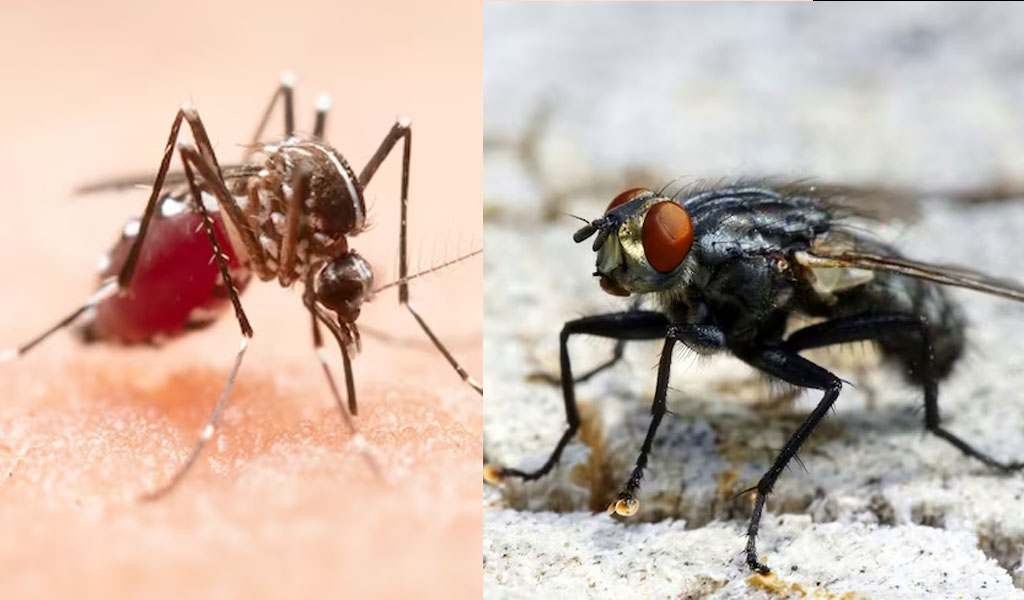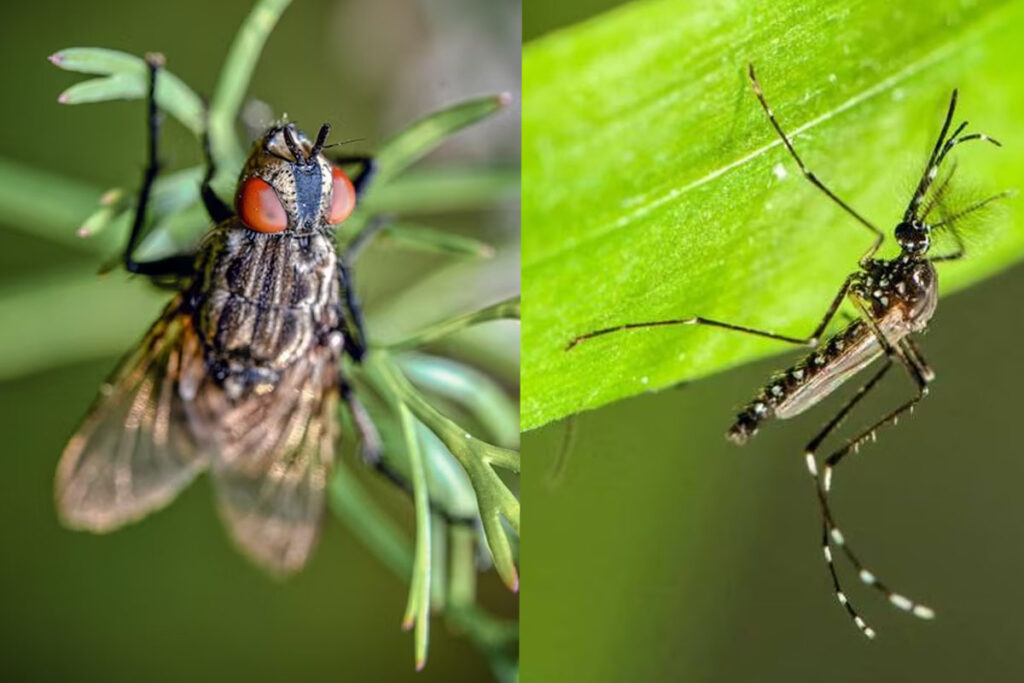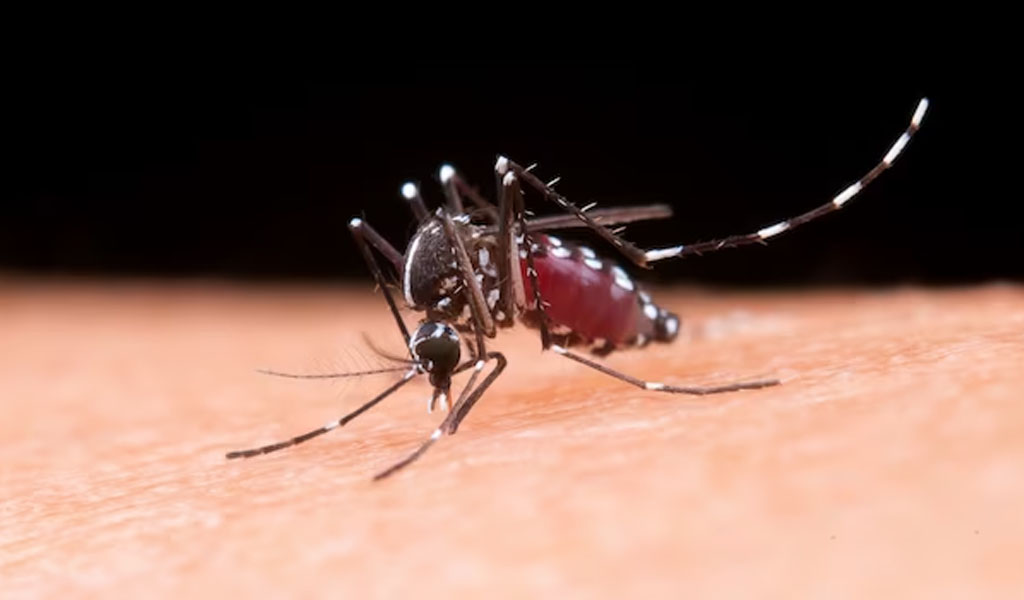Flies and mosquitoes: Differences and Affinities

When talking about flies and mosquitoes, questions about the differences between the two species are common. Although both insects can be annoying and can carry diseases, there are characteristics that distinguish them. Here is some detailed information about the peculiarities of flies and mosquitoes.
Flies and Mosquitoes: What makes them different?
Flies and mosquitoes are two common types of flying insects that often cause annoyance to people. Although they share some similar characteristics, they also have significant differences in their appearance, behaviour and habits.
Morphology:
Flies: Flies have a stout, compact body. Their wings are transparent and membranous, and they usually have a pair of short antennae.
Mosquitoes: Mosquitoes have a more slender, elongated body. Their wings are covered with scales and they usually have a pair of long, thin antennae.
Lifetime:
Flies: The life span of flies varies according to species and environmental conditions. In general, adult flies have a relatively short life span, ranging from several weeks to months, depending on factors such as food availability and climate.
Mosquitoes: The lifespan of mosquitoes also varies according to species and environmental conditions. On average, adult mosquitoes usually live 2-4 weeks, although some may live up to 2 months.
Size and number of species:
FliesThere are numerous species of flies throughout the world, ranging in size from a few millimetres to about 15 mm. Some of the most common species include the house fly (Musca domestica) and the fruit fly (Drosophila melanogaster).
Mosquitoes: There are also many species of mosquitoes around the world, ranging in size from approximately 2 to 25 mm. Some notable species include the Aedes mosquito, responsible for transmitting diseases such as dengue and Zika, and the Anopheles mosquito, which transmits malaria.
Habitat
Flies: are found in a wide variety of habitats, from urban to rural environments. They are often found near food sources, such as litter, excreta and decaying organic matter.
Mosquitoes: are most common in areas where standing water is present, such as ponds, puddles and wetlands. They depend on water for reproduction and to complete their life cycle.
Diseases they transmit:
Flies: Although flies are not usually directly dangerous to humans, they can carry bacteria, viruses and parasites. These micro-organisms can be transmitted to food and surfaces, potentially leading to infections and diseases such as gastroenteritis, salmonella and dysentery.
Mosquitoes: are known to be vectors of infectious diseases. Some mosquito species transmit diseases such as dengue fever, malaria, West Nile virus, Zika, yellow fever and encephalitis. These diseases can be serious and even fatal in some cases.
Behaviour:
Flies: Flies are active during the day and tend to move quickly from place to place. They often land on surfaces and food, and can be a nuisance in domestic or picnic environments.
Mosquitoes: Mosquitoes are most active during twilight and nighttime hours. They have a slower flight and often bite humans and other animals to feed on their blood.
Food:
Flies: Flies feed on a variety of foods, including decaying organic matter, excreta and food scraps. They are considered opportunistic insects and can transmit bacteria and diseases.
Mosquitoes: Female mosquitoes feed on blood to obtain the nutrients necessary for the development of their eggs. Male mosquitoes, on the other hand, feed on flower nectar.
Life cycle:
Flies: Flies undergo complete metamorphosis, including egg, larva (maggot), pupa and adult stages. Development time from egg to adult may vary with species and environmental conditions.
Mosquitoes: Mosquitoes also undergo complete metamorphosis. Females lay their eggs in water, and the larvae develop in that aquatic environment. After pupating, they emerge as adult mosquitoes.
Reproduction:
Flies: Flies can reproduce rapidly and lay eggs on different substrates, such as decaying organic matter or exposed food. They can lay hundreds of eggs in their life cycle.
Mosquitoes: Mosquitoes breed in standing water sources, where females lay their eggs. Depending on the species, they may lay a variable number of eggs, usually in clusters or floating on the surface of the water.
Chemical resistance:
Flies: Some fly species have developed resistance to certain insecticides and can be difficult to control in agricultural or urban environments.
Mosquitoes: Some mosquito species have also developed resistance to certain insecticides, making it difficult to control them in areas where they are disease carriers.
| Aspect | Flies | Mosquitoes |
|---|---|---|
| Morphology | Robust body and membranous wings | Slender body and scale-covered wings |
| Behaviour | Erratic and fast flight | Smoother and quieter flight |
| Feeding | They feed on decaying matter | Haematophagous, they feed on blood. |
| Life cycle | Complete metamorphosis (egg, larva, pupa, adult) | Complete metamorphosis (egg, larva, pupa, adult) |
| Reproduction | Deposit eggs in organic matter | They lay eggs in stagnant water |
| Chemical resistance | Some species may develop resistance | Sensitive to certain insecticides |
| Lifetime | Adult life of approximately 1-4 weeks | Adult life of approximately 2-4 weeks |
| Size | They vary in size, but are generally larger than mosquitoes. | They vary in size, from small to larger |
| Number of species | It is estimated that there are about 120,000 species of flies. | It is estimated that there are about 3,500 species of mosquitoes. |
| Danger/Disease | Can transmit bacteria and gastrointestinal diseases | Some species transmit diseases such as dengue, malaria and Zika. |

Factors that Attract Mosquitoes
Mosquitoes have the ability to detect certain factors that attract them to people. Although some people may be more prone to mosquito bites than others, there are a number of things that can attract mosquitoes:
Body Odour and Carbon Dioxide
Mosquitoes are attracted by body odour and the carbon dioxide we emit when we breathe. Each individual has a unique chemical composition, which may influence their attraction to mosquitoes.
Heat and Humidity
Mosquitoes are more active in warm and humid climates. Body temperature and humidity can make a person more prone to mosquito bites.
Colour of Clothing
Mosquitoes are attracted to dark colours, especially black and navy blue. If you wear light-coloured clothing, mosquitoes are less likely to find you attractive and bite you frequently. Opting for light-coloured clothing can help reduce bites.
Skin Chemicals
Certain chemicals present on the skin, such as lactic acid, ammonia and uric acid, can attract mosquitoes. These substances occur naturally in our bodies, and some people may have higher levels, making them more attractive to mosquitoes.
Physical Activity
Exercise and physical activity increase the production of carbon dioxide and body heat, which can make people more attractive to mosquitoes. It is advisable to take extra precautions when engaging in outdoor activities during times when mosquitoes are most active.
Measures to Prevent Mosquito Bites
If you want to avoid mosquito bites, both indoors and outdoors, it is important to take preventive measures. Here is a list of actions you can take:
In the Interior:
- Use mosquito nets on doors and windows to prevent mosquitoes from entering your home.
- Keep your home clean and free from sources of standing water, where mosquitoes can breed.
- Use insect repellent spray or lotion on exposed areas of skin.
- Install ceiling or floor fans to keep the room cool and to keep mosquitoes away, as they prefer quiet, draught-free environments.
Abroad:
- Avoid going out at dawn and dusk, when mosquitoes are most active.
- Wear long-sleeved clothing and long trousers to cover most of your body.
- Apply insect repellents to exposed skin and clothing according to product directions.
- Use mosquito nets on beds and outdoor sleeping areas.
- Regularly remove or empty containers with standing water, such as flower pots, old tyres or buckets, where mosquitoes can breed.
In a nutshell, Both flies and mosquitoes are insects that can cause discomfort and transmit diseases.. Flies are attracted to sources of food and waste, while mosquitoes seek blood for breeding. Several factors, such as body odour, temperature, colour of clothing and physical activity, can influence the attraction of mosquitoes to people.
To prevent mosquito bites, it is recommended to use preventive measures both indoors and outdoors, such as using mosquito nets, insect repellents and avoiding standing water. By following these recommendations, you can reduce the likelihood of getting bitten and enjoy a more fly and mosquito-free environment.
Remember that prevention and care are key to keeping these insects at bay and protecting your well-being. We hope this information has been useful to you and invites you to take the necessary measures to maintain a more comfortable and nuisance-free environment.
If you would like to find out more about our models of fixed mosquito nets, pleated mosquito nets or insect screens for side doorsamong other designs, do not hesitate to contact us. You can also request the option of anti-pollen mosquito nets in case you are an allergic person. We will be happy to help you.







